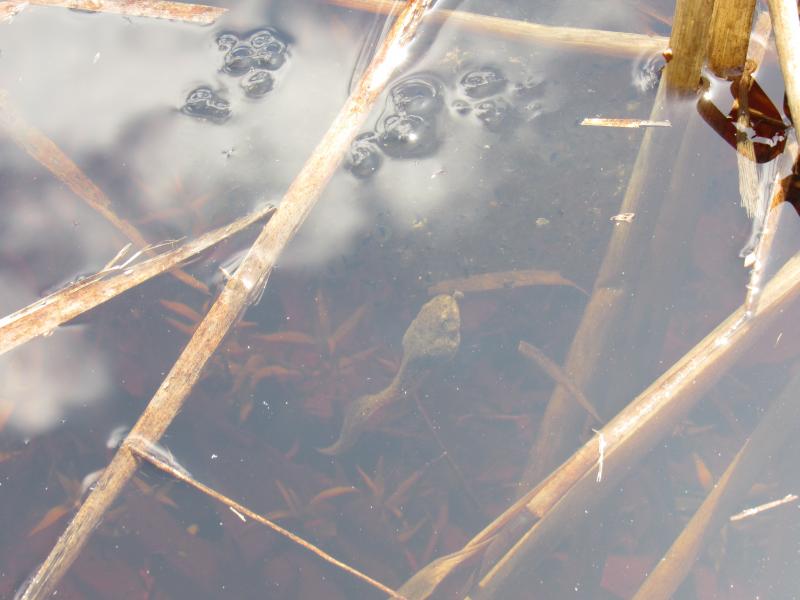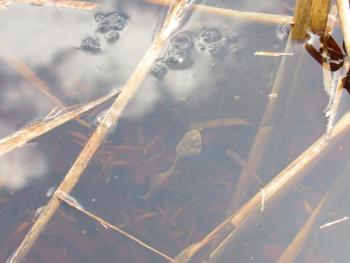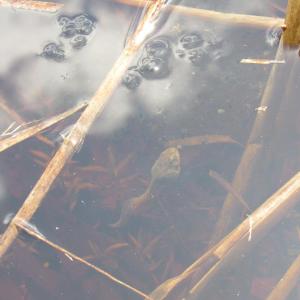Kristen Lindquist: The season of bullfrogs
On an early spring visit to our friends' farm in Lincolnville, we all strolled down to the farm pond to see if we could find any frog's eggs. Sure enough, we spotted the gelatinous masses of wood frog eggs and the smaller, more opaque blobs of spotted salamander eggs. These species are typically among the first to lay eggs in a vernal pool or frog pond. We were surprised, however, to then observe tadpoles. Tadpoles already? Not only that, but these tadpoles were huge, much bigger than a wood frog tadpole would be. In fact, they seemed to be nibbling on the wood frog egg masses. Where had these freaks of nature come from? What were they?
I figured tadpoles of that large size had to be young bullfrogs, but bullfrogs hadn't even emerged yet, let alone laid eggs. Turns out that bullfrog tadpoles hibernate! The big ones we were seeing had hatched out last summer or even the summer before. They had then hibernated under the ice thanks to amphibian antifreeze in their veins, and emerged hungry and active in early spring. Bullfrog tadpoles can take up to five summers before they metamorphose into adult frogs, but most hibernate for two winters and take the leap into frog adulthood in their third summer. This extended childhood makes sense when you realize that the bullfrog is the largest frog in North America; the more time a tadpole has to grow and develop, the larger it will be as a frog.
Bullfrogs are slow to develop in other ways, too. The adult frogs are among the last to emerge each spring, well after the tadpoles. The males remain silent for up to a month or more after they emerge because they court and mate later than other Maine frogs, waiting until mid- to late-June and July. And once the tadpole has metamorphosed into a frog, it then takes four to five years for the frog to become sexually mature.
While we did watch bullfrog tadpoles seeming to feed on wood frog eggs, they're primarily vegetarian at that stage. Adult bullfrogs, however, will enthusiastically eat pretty much anything they can grab and fit in their mouths, from bugs, spiders, and snakes to fish, small rodents, and even birds. They'll also cannibalize smaller bullfrogs. Some rather dramatic videos on YouTube show bullfrogs swallowing mice, eating a scorpion, and leaping up to grab a bird. A bullfrog will apparently eat a bird whole—beak, feathers, and all; it must have a cast-iron stomach.
The bullfrog eats whatever it can get, and we eat the bullfrog, frog's legs being a noted Southern delicacy. My husband says they taste like chicken. Interestingly, in some states—not including Maine—the bullfrog is actually classified as a game species, the only amphibian to carry that status. Herons are another avid predator of bullfrogs, as well as raccoons, minks, otters, and snakes that have grown large enough not to become prey themselves of this aggressive amphibian.
If spring evenings are characterized by peepers, summer nights are the time of the bullfrogs. In June we begin to hear that quintessential sounds of the summer pond: the bullfrog's deep, resonating courtship song, usually described as, "Rum, rum, jug o' rum." (Jeremiah the bullfrog's "mighty fine wine" notwithstanding, the bullfrog appears to prefer hard alcohol.) A bullfrog's roaring-bull voice carries extremely well and can keep you up at night, no matter how nostalgic you are about your summer nights in the family camp on the lake.
The area in which courting males are hanging out and singing is called the booming ground, which I liken to a froggy battle of the bands—or maybe battle of the drummers or bass players would be more appropriate. The concept, in which a bunch of males gather to hopefully attract the attention of females, is similar to that of prairie chickens on a lek. From the female's perspective, apparently the more males singing together, the better, although these large congregations necessitate a (usually age-based) social hierarchy among them. Interestingly, recent studies have shown that contrary to prior belief, males do not mate with any frog in sight, but only respond to females that initiate contact. Would that all human males might follow that example.
Besides that the males are the ones doing all the "booming," you can tell them apart from females by the size of their eardrum, that big external circle behind its eye: on males, this is larger than the eye; on females, about the same size as the eye. The males also sport yellow throats. Also, if you see a pair in amplexus, the mating embrace, he's the (usually smaller) one on top. While the name "bullfrog" makes us think of every individual as male, female bullfrogs are generally larger than the males. (I guess "cowfrog" is not an acceptable moniker for the female bullfrog.) I like to think that thanks to her size she can at least hold her own. Given the bullfrog's appetite, if she's unhappy with her mate, she could always just turn around and eat him.
 Kristen Lindquist is an amateur naturalist and published poet who lives in her hometown of Camden.
Kristen Lindquist is an amateur naturalist and published poet who lives in her hometown of Camden.
Growing your natural literacy, one Maine state symbol at a time
Snow Buntings—Bringing winter to life
Winter life inside a beaver lodge
Migrating flickers and falcons
Orchids —They're not just in the tropics
• Meditations on an unlikely harbinger of spring
• Meditations on the Snow Goose
• Sky-watching during the holiday season
• Understanding the Aurora Borealis
• Get to know the constellation Gemini
• Celebrate September’s full moon
• Northern Sky basics with the Big Dipper
• Early Christmas morning: Look up! A full moon, and Orion bright in the sky
Event Date
Address
United States
























